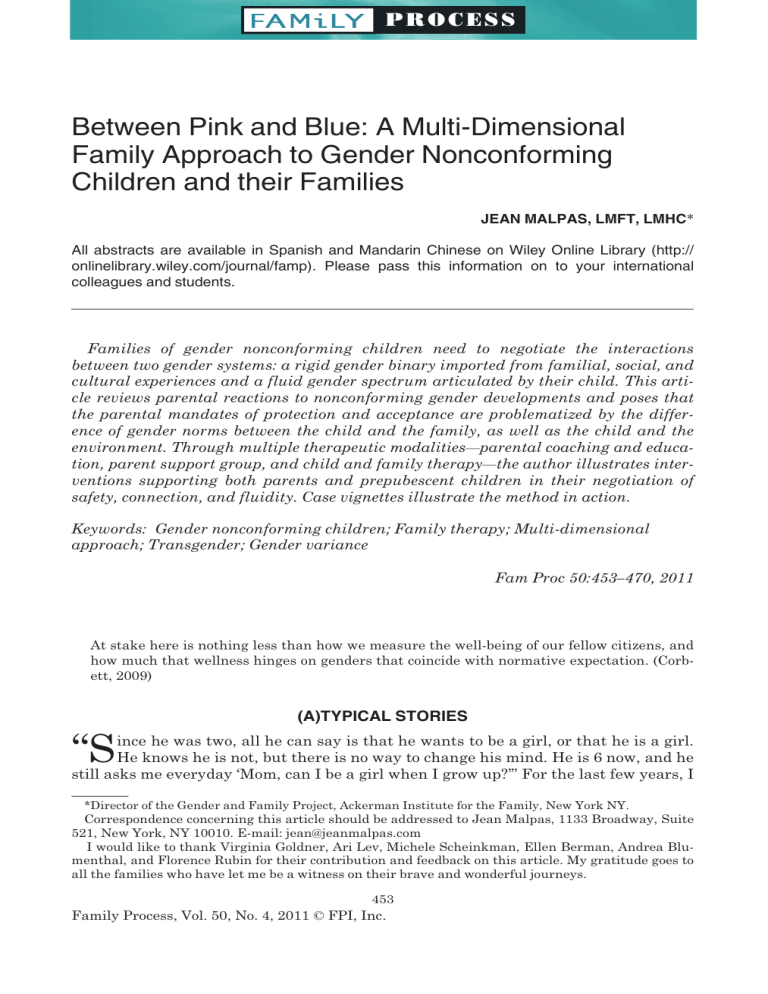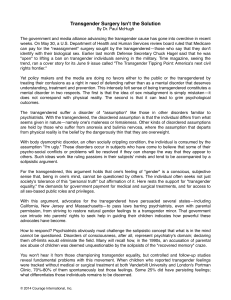
PROCESS Between Pink and Blue: A Multi-Dimensional Family Approach to Gender Nonconforming Children and their Families JEAN MALPAS, LMFT, LMHC* All abstracts are available in Spanish and Mandarin Chinese on Wiley Online Library (http:// onlinelibrary.wiley.com/journal/famp). Please pass this information on to your international colleagues and students. Families of gender nonconforming children need to negotiate the interactions between two gender systems: a rigid gender binary imported from familial, social, and cultural experiences and a fluid gender spectrum articulated by their child. This article reviews parental reactions to nonconforming gender developments and poses that the parental mandates of protection and acceptance are problematized by the difference of gender norms between the child and the family, as well as the child and the environment. Through multiple therapeutic modalities—parental coaching and education, parent support group, and child and family therapy—the author illustrates interventions supporting both parents and prepubescent children in their negotiation of safety, connection, and fluidity. Case vignettes illustrate the method in action. Keywords: Gender nonconforming children; Family therapy; Multi-dimensional approach; Transgender; Gender variance Fam Proc 50:453–470, 2011 At stake here is nothing less than how we measure the well-being of our fellow citizens, and how much that wellness hinges on genders that coincide with normative expectation. (Corbett, 2009) (A)TYPICAL STORIES “S ince he was two, all he can say is that he wants to be a girl, or that he is a girl. He knows he is not, but there is no way to change his mind. He is 6 now, and he still asks me everyday ‘Mom, can I be a girl when I grow up?’” For the last few years, I *Director of the Gender and Family Project, Ackerman Institute for the Family, New York NY. Correspondence concerning this article should be addressed to Jean Malpas, 1133 Broadway, Suite 521, New York, NY 10010. E-mail: [email protected] I would like to thank Virginia Goldner, Ari Lev, Michele Scheinkman, Ellen Berman, Andrea Blumenthal, and Florence Rubin for their contribution and feedback on this article. My gratitude goes to all the families who have let me be a witness on their brave and wonderful journeys. 453 Family Process, Vol. 50, No. 4, 2011 © FPI, Inc. 454 / FAMILY PROCESS have received an increasing number of calls from parents who share similar stories. Parents usually reach out when they are distressed or unsure about how to handle the nontraditional gender expression or cross-identification of their son or daughter. The children can be as young as 2 years old or as old as the legal age. Most of the time, they have a good grasp of social norms and, in accordance with the developmental stages of gender constancy (Cohen-Kettenis & Pfafflin, 2003), are able to differentiate between a man and a woman, understand how boys and girls are supposed to look and behave, and pinpoint when something is out of line. “One day, my 6-year-old boy insisted on dressing as Tinkerbell for a party. My husband asked him if he, himself, could also wear a dress. Our boy looked puzzled. He threw his hands up in disbelief and said: ‘Of course not. You are a man. Men don’t wear dresses!” What stands out is how increasingly adamant these children are about claiming cross-gendered preferences and identifications, with or without distress about their own bodies. As other clinicians have reported (Corbett, 2009; Pleak, 1999), a large proportion of parents accepts gender-variance, while being mainly concerned for their child’s welfare and unsure about the adequate ways to handle the challenge (Brill & Pepper, 2008; Ehrensaft, 2011; Menvielle, 2009). Of course, parents who strongly reject gender nonconformity might be less likely to call a therapist known for his/her nonpathologizing stance on this matter. However, most parents who reach out have a clearly supportive stance. They are frequently familiar with the concept of gender as a fluid continuum rather than a rigid binary (Lev, 2004, 2010; Malpas, 2006; Malpas & Lev, 2011) and, as Ken Corbett puts it, they do not consider that their child has a psychopathological problem, but rather a social problem. “Their son does not fit the social category of boy. He is a category crisis” (Corbett 2009, p. 122). Other times, the family picture is more complicated and, because of community pressure or personal beliefs, parents—most often fathers—struggle to accept a child who does not fit within social gender norms. Some are willing to accept a gay or lesbian child and/or minor gender nonconformity as an outcome (Brill & Pepper, 2008). They dread the possibility of discovering that their child might be heading toward a transgender identity and a desire to change sex. Some react very negatively and the gender nonconformity can become a significant source of conflict between parents and a damaging source of disconnection between parent and child. The Multi-Dimensional Family Approach (MDFA) supports gender nonconforming children and their parents in negotiating a series of tasks, often ordinary to the life cycle of prepubertal child-rearing families, yet highly complicated by the nonconformity of the child. Whether accepting or struggling, parents face the difficult task of having to position themselves, at home and in the world, at the intersection of two parenting mandates that usually do not conflict as acutely: nurture their child’s personhood while promoting his/her adjustment to consensual social realities. Another dilemma is the struggle of parents to make crucial decisions regarding the gender of their child (such as changing his/her name and pronoun, navigating social transition, allowing fluidity of gender expression) while not knowing which identity he or she will affirm as an adolescent and adult. Parents face the difficult task of remaining flexible while affirming the child in his/her current embodiment. These tasks must be negotiated in the contexts of both supportive and judgmental social contexts where gender nonconformity is sometimes embraced, but most often, a painful source of stigma, oppression, isolation, bullying, and even murder (Greytak, Kosciw, & Diaz, 2009; Menvielle and Tuerk, 2002). www.FamilyProcess.org / 455 MALPAS DIAGNOSIS AND TREATMENT Ethical Questions The psychiatric diagnosis of gender nonconforming and transgender children presents critical ethical questions (Hill, Rozanski, Carfagnini, & Willoughby, 2007; Hill et al., 2010; Pleak, 1999). Several authors debate whether the diagnostic category of “Gender Identity Disorder in Childhood” should exist in the DSM (American Psychiatric Association, 2000; Lev, 2005; Winters, 2005) and suggest that the diagnostic entity has “reinscribed a traditional male/female gender binary with corresponding appropriate masculine and feminine behavior” into the social order (Rottnek, 1999, p. 1). There are no epidemiological studies providing data on the prevalence of childhood Gender Identity Disorder (GID) (Pleak 2009), so estimations come from indirect sources. In the Netherlands, the estimated prevalence of transgender adolescents ranges from 1/10,000 in boys to 1/30,000 in girls. In the United States, anecdotal data reported by the Transgender Youth Family Alliance claim that about one in five hundred children presents as cross-gendered identified in the schools and communities they have visited (K. Pearson, personal communication). The question of adult trajectory—whether childhood gender nonconformity typically evolves into transgender identity or mostly represents a childhood manifestation of a homosexual or bisexual orientation—is one of the most complex controversies (Minter, 1999; Pleak, 1999). Initial studies by Green (1987) and Zucker and Bradley (1995) suggested that most gender nonconforming children would later identify as gay or lesbian, while only a small percentage (up to 6%) would persist as transsexual adults. A recent Dutch study (Wallien & Cohen-Kettenis, 2008) points to a higher percentage (27%) of youth persisting in their desire to change sex after the age of 12. However, this study might significantly underestimate the number of transgender youth in the cohort. It does not include transgender-identified youth who do not seek Gender Confirming Surgery (GCS), or data from the studied cohort at an adult age. Current clinical wisdom affirms that children whose gender nonconformity has the earliest onset as well as the most intense expression and dysphoria are more likely to cross-identify as adolescents and adults (Menvielle, 2009; Wallien & Cohen-Kettenis, 2008). A continuous cross-gender identification past the age of 15 is usually considered stable (Pleak, 2009). Psychiatric Approach Traditional reparative approaches have mainly focused on gender nonconforming boys and have used cognitive-behavioral and psychodynamic methods (Hill et al., 2010) to extinguish atypical gender behaviors and identifications and reinforce gender typical activities and loyalties, particularly the father/son relationship (Green, 1987; Meyer-Bahlburg, 2002; Reckers, 1995; Zucker & Bradley, 1995). Treatment rationales varied from the prevention of homosexuality (Reckers, 1995), social ostracism, and adult transgenderism as well as the alleviation of underlying or associated psychopathology (Green, 1987; Meyer-Bahlburg, 2002; Zucker & Bradley, 1995). However, there is little evidence that treatment of GID in children significantly impacts later sexual or gender identity. More importantly, attempts to alter or manipulate a child’s Fam. Proc., Vol. 50, December, 2011 456 / FAMILY PROCESS future sexual orientation and/or gender identity have raised serious ethical and legal questions (Minter, 1999). Affirmative Approach Given these concerns as well as the failure of clinical treatment to systematically change gender identity or sexual orientation, contemporary approaches to gender nonconformity in childhood are moving toward an affirmative standpoint (Brill & Pepper, 2008; Cohen-Kettenis & Pfafflin, 2003; Cohen-Kettenis, Delemarre-van de Waal, & Gooren, 2008; Corbett, 2009; MacNish & Gold, 2011; Hill et al., 2007, 2010; Lev, 2004; Lev & Malpas, 2011; Malpas, 2010; Mallon, 2009; Menvielle, 1998, 2009; Pleak, 1999, 2009; Rosenberg, 2002; Saeger, 2006; Vanderburgh, 2008). These perspectives consider gender as a fluid spectrum and claim that (1) gender nonconformity is not a pathology but a normal human variation, (2) gender nonconforming children do not systematically need mental health treatment, and (3) care-givers of gender nonconforming children can benefit from a mixture of psycho-educational and community-oriented interventions. These aim at de-stigmatizing and normalizing their experiences while offering tools to negotiate their children’s safety, wellbeing, and optimal development in their familial and natural environment. Clinical interventions with children focus on affirming their sense of self-confidence and increasing social integration, while providing a platform for reflection on choices related to gender expression and identification. Treatment with prepubescent children might include supporting their social transition. It consists of changing the child’s social status and gender attributes—such as name, pronoun, clothing, official documentation, and registration in gendered activities and schools —in alignment with their gender identity, without making any definitive medical changes. As they reach the beginning of puberty (Tanner Stage 2) and with their parents’ consent, some teenagers can chose to undergo hormonal treatment (Cohen-Kettenis and Pfafflin, 2003; Hembree et al., 2009; Wallien & Cohen-Kettenis, 2008). The hormonal intervention will block the puberty in the biological sex until the adolescent’s decision is clear and definite enough. One of the greatest advantages of this intervention is that it avoids the unnecessary masculinization or feminization of the body, which can be experienced as emotionally excruciating for some transgender adolescents (Cohen-Kettenis and Pfafflin, 2003; Pleak, 2009). It also avoids irreversible changes imposed on the body by the influence of testosterone. Later on and on a case-by-case basis, adolescents and their caregivers may decide to move to the second stage of medical treatment. This stage involves administering cross-hormones, which will initiate puberty in the gender of identification. GCS (e.g., genital surgeries and/or “top surgeries”) are the next component of medical treatments for older teenagers. Affirmative approaches have placed increasing importance on working with parents (Menvielle, 1998, 2009; Menvielle & Tuerk, 2002; Pleak, 1999, 2009). Interventions with parents emphasize adjustment to the social difference of the child and promote restoration and flourishing of the parent–child bond. Focus is also placed on self-help, peer-advocacy, and education of larger social institutions (Boenke, 1999; Greytak et al., 2009; Mallon, 2009). www.FamilyProcess.org MALPAS / 457 A MULTI-DIMENSIONAL FAMILY APPROACH: AFFIRMING CHILDREN AND PARENTS The Both/And Stance: Protection and Acceptance, Adaptation, and Nurturing One of the major goals is for parents and children to move from an experience of “either/or” to one of “both/and.” Children can both affirm their identity and understand the demands of a world mostly organized around the mutually exclusive binary of gender. Parents can both nurture their child’s singularity and operate as mediator between the child’s wish and the social reality. The clinician’s ability to move flexibly between multiple positions within the family —consultant and coach for parents, family and/or child therapist, and parent group facilitator—provides support to the system where it needs it the most. The clinician’s mandate can also include empowering families and/or directly advocating for the gender nonconforming children in communities and schools. Parents are the pillars of this therapeutic model. Goals include increasing their acceptance of the gender fluidity and facilitating harmony between the child and his or her environment, beginning in the family of origin. Once they decrease their own anxiety, parents can control their fears and reactivity and can differentiate their child’s needs from their own. They can also advocate and promote flexibility of gender norms in social contexts, starting with schools, faith communities, neighborhoods, family friends, extended families, expanding outward to social medias and cultural messages. The following sections describe the components of the MDFA: (1) Parental engagement and education; (2) Individual assessment and child therapy; (3) Parental coaching; (4) Systemic family therapy, and (5) Parent support group. Clinical vignettes illustrate the method in action. Parental Engagement and Education A first meeting with parents It is generally recommended that the therapist consult with the parent(s) before meeting with the larger family system and the child. Parents are the decision makers and therefore an initial therapeutic alliance needs to be created with them. After hearing the presenting problem and the precipitating factors leading to the consultation, it is important to inquire about the parents’ responses to the atypical journey of their child. Those often include shock, fear, anger, sadness, shame, or even disgust. Their confusion, guilt, or sense of loss gets easily entangled with their ability to feel acceptance for and pride in their child. The privacy of these conversations also offers the chance to discuss their belief systems and reactions to homosexuality and transgenderism. Mapping the gender traditions and flexibility of both parents, their families and cultures of origin through a genogram clarifies the potential points of conflict and alliances between parents and with significant family members around the child. The second step of parental engagement aims at getting a detailed account of the child’s gender development (including his/her choice of friends, clothing, and toys, the gender of the his/her character in role plays, his/her relationship with adult family members and siblings). A careful timeline of the child’s self-identification (“I am a boy/girl”) and relationship to his/her body (particularly genitals and other people’s Fam. Proc., Vol. 50, December, 2011 458 / FAMILY PROCESS secondary sexual characteristics) constitutes one of the tools used to assess the child’s nonconformity and potential gender dysphoria (distress about the body, genitals, and the fact of living socially in the assigned gender). Comprehensive information about the child’s emotional and social functioning, as well as school performance, should be collected in relation to both the overall development of the child and the potential secondary psychosocial stressors induced by the gender nonconformity. It is critical to assess the degree of acceptance or rejection the child is or could be encountering at school and in other social communities. A significant part of the conversation reviews whether there are signs of immediate danger to the child, such as teasing or bullying in the child’s social environment and/or extended family. Parents are encouraged to check with teachers, school administration, and after-school programs as research shows that gender nonconforming youth tend to considerably underreport their experiences of harassment in school (Greytak et al., 2009). Psychoeducation Psychoeducation on these issues is a substantial component of the MDFA. “What will become of my child as an adolescent and as an adult - in other words, can we tell whether he or she will be transsexual?” and “What can we do about it?” are two of the most frequent questions parents ask. While parents have often researched the issue of transgender children thoroughly and are quite expert on the topic, it is useful to assess their level of information or potential misinformation, and review the existing research. In the spirit of transparency, clinicians should clarify their position on gender nonconformity as a normal human expression and admit that predicting the adolescent and adult future of a gender nonconforming child is nearly impossible. It is helpful to review the difference between sex, gender, and sexual orientation and convey that research shows that (1) a large majority of gender nonconforming children might become gay and lesbian; (2) some children persist in their cross-gender identification as adolescents and adults; (3) other children’s gender nonconformity will phase out and their sexual orientation will be heterosexual; (4) still others will remain gender atypical and be heterosexual. Initial conversations should emphasize how critical the parents’ roles are, not in the making of gender nonconformity, nor in the curing of it, but in their ability to find collaborative ways to nurture their children, to affirm their personality and choices. They are essential in setting limits, ensuring safety, and preparing themselves to make informed decisions about potential medical and social transition or lack thereof. Therapy can support them in finding an optimal pace— without anxiously holding back or pushing their child forward—where they let the child show them the way to his/her self-actualization, while they remain in charge of choosing the safest and most loving roads. Treatment plan Careful attention during initial assessment sometimes reveals that the child is not in crisis, but the parents are. In these circumstances, in addition to assessing the child, parental coaching and parents group can be sufficient interventions. Children who do not present signs of distress about their gender nonconformity, who are not oppressed or endangered by external reactions and who do not ask to talk about their identity might not necessitate ongoing psychotherapy beyond the initial assessment. It is unnecessary to take the risk of creating more stigma or distress for the child www.FamilyProcess.org MALPAS / 459 when his/her parents, for the time being, are the ones who need help. In most cases, however, parents ask for the evaluation of their child’s level of distress. Children are also eager to find a space where their fluidity and differences can be normalized. Clinical vignette “Nicky is a force of nature,” said her parents, Terry and Albert. “She is eight and she has pretty much transitioned herself at school. She has asked her friends to call her ‘Nick’ and has not even cared to ask us about it!” exclaim Terry and Albert, with a mixture of fascination and bewilderment. Like many parents I encounter, they have done a lot of research on the topic and are connected to a national parents’ listserve, which has referred them to my parents’ support group and potentially family therapy. “This pretty much started 3 years ago. Before the age of 5, she had mixed preferences in toys and activities. She had girlfriends and boyfriends and even had a crush on a boy. It started changing in first grade. She started to play with boys only, to want to wear jeans and neutral clothing. Because she was a girl, we did not think much of it and did not realize something deeper was changing. Maybe that’s the difference between gender nonconforming boys and girls? By the end of first grade, she said she was a ‘tomboy.’ We assumed she heard that at school. In second grade, she gradually refused to wear anything girly, including bathing suits and underwear. At the beginning of third grade we agreed to give her a shorter haircut. It’s still curly, you know, but it’s much more androgynous.” Terry and Albert were very supportive, yet preoccupied: “We love her no matter what. We thought she might be lesbian, which would be absolutely fine with us. But it seems to be more than that. She has expressed wanting to be a boy, even being a boy and has asked us to call her Nick as well.” Albert continued, “The most difficult aspect is that she does not want to talk to us about it. When we approach the topic, she shuts down or she just leaves the room. I have even tried indirectly by choosing a program on gender nonconforming children on TV and she had a tantrum. I think she feels embarrassed. We don’t want to put her on the spot but we are trying to find a way to be with her and figure out what she is going through.” Our first conversation examined in detail the stages of Nicky’s gender, social, and psychological development. We clarified that, although unsure about what strategies to adopt, Terry and Albert had insured that school was a safe place and that Nicky was not endangered or teased by teachers, peers, or other parents. Besides her reluctance to talk about her gender concerns, Nicky was not expressing other major signs of distress. She was sometimes anxious and had always been a “strong personality” but her social and family life was thriving and her school performance satisfying. We agreed that she should come in for an evaluation with me. Terry and Albert had already suggested talking to a “feeling doctor” but she had strongly refused. They wanted to avoid pressuring her unnecessarily and, rather, wanted to find a strategy that would put her less on the spot. They decided to start by telling her about their appointment with me. They expressed their desire to meet as a family with me, since I was working with other children like her. Terry and Albert left the first session feeling relieved that they had had the opportunity to tease out the different aspects of their situation with someone who had heard similar stories. They told Nicky that they were joining a group of parents of other children like her. Nicky barely reacted to the news and, initially, didn’t express interest in joining her parents for a family conversation. Terry and Albert, however, poured Fam. Proc., Vol. 50, December, 2011 460 / FAMILY PROCESS their hearts out in the parents’ group and gradually became accustomed to calling their daughter “Nick.” Encounter and Assessment: Working with Children Encounter Gender nonconforming children often express directly what brings them to therapy. “We are going to talk about how I want to be a girl and if I can go to school as a girl next year,” stated Tom, a 7-year-old gender nonconforming boy, at his first session. When the child opens the encounters with such clarity, it behooves the therapeutic alliance to respond with as much transparency as possible. “Great! So we are here to talk about how you see and feel about yourself as a boy or a girl,” might be a response attuned to the straight-forwardness of the child. A clear identification of the centrality of gender makes the implicitly known explicitly available for exploration. The initial encounter aims to create a space where children and their subjectivity can be seen more fully (Corbett, 2009). Tone and content should consciously avoid stigmatizing the child and reifying the often already existing identified patient dynamic. It can be done by asking about the family’s daily life, joys, activities, and prideful stories as well as inquiring broadly about sibling relationships and friendships. The session should be age-appropriate by balancing conversation with creative and physical time: role playing, moving around, drawing on the floor, looking at family pictures, and telling stories. Assessment One of the delicate aspects of the initial work with children is combining a genuine and open encounter with the assessment mandate. Assessment aims at differentiating whether the child is gender nonconforming or transgender, therefore experiencing a more profound distress with the gender assigned at birth. Open dialogues about favorite friends, toys, activities, and the choice of character in role plays, as well as live observation of interest in stereotypically masculine or feminine toys, provide a wealth of information about the child’s gender identity and gender role expression. Several instruments, such as the “Drawing of a Person” test (Meyer-Bahlburg, 2002), the “Gender Identity Interview” (Zucker, Bradley, Lowry Sullivan, Kuksis, BirkenfeldAdams, & Mitchell, 1993, p. 448), and the “Gender Preferences Questionnaire” (Cohen-Kettenis & Pfafflin, 2003, p. 112), provide data while opening up conversations about the child’s comfort with his/her body, genitals, and preferred position in the bathroom, as well as the gender of the adult they imagine themselves to become. While parents’ reports most often accurately depict the intensity and depth of the gender nonconformity of their child (Johnson et al., 2004), it is important to hear the account directly from the child. In some cases, parents’ anxiety and coping mechanisms participate in underestimating or overestimating the level of distress or the clarity of the child’s wish to identify with one particular gender. Not all gender nonconforming children are transgender. However, certain characteristics are commonly found in children with gender dysphoria as opposed to gender nonconforming children with little angst about their physical body or desire to crossidentify. Clinical and nonclinical observations (K. Pearson, personal communication) show that children with gender dysphoria often present specific features. While common, they are not always all present or all present at the same time. These are: www.FamilyProcess.org MALPAS / 461 (1) an adamant desire to be the other gender. Their gender expression does not come across as a loose preference or fluidity with gender norms; it instead conveys passion for the gender with which they identify; (2) an acute distress over being identified with their gender of birth. Enforcing behaviors and norms associated with their birth gender often triggers intense conflict, opposition, or depression; (3) a persistence over time (at least several years) in identification, gender role expression, and desire to change gender. As most parents report, their gender identity does not appear to be a phase, nor feel conflicted, ambiguous, or problematic. Instead, transgender children clearly take pleasure in being who they are. As a matter of fact, inquiring about why they feel this way often leads nowhere. Their gender seems to impose itself on them. It is neither a choice nor a dilemma. It just is; and (4) body dysphoria. This feature is not always present, and is more likely to appear when children approach puberty and understand the symbolic importance of their anatomy as well as the permanency of their physical sex. Some transgender children can experience profound distress in their natal anatomy. Lastly, assessment should include conversations about comfort in school and potential instances of bullying and teasing as experienced currently or throughout their family and education history. While younger boys and girls tolerate gender fluidity rather well, children over 5 or 6 years of age become more invested in gender policing. For instance, groups of girls might reject a gender nonconforming boy because he is not a “real girl” (Pleak, 2009). Clinical vignette A few weeks after his parents joined the support group, Nick became anxious about developing breasts and asked his mom what they could do about it. Terry suggested that they all come to talk to me. Nick was ready and accepted right away. “I am here to discuss the boy/girl thing,” said Nick, when he first sat in my office. “Would you like us to talk alone, without mom?” I asked Nick after a long silence. “Yes!” he responded. Terry ruffled his hair tenderly and walked out, saying “I’m out here, honey. You can tell Jean whatever you want.” As Terry closed the door, I asked Nick what he wanted to talk about. “I know you work with other children like me. I am afraid I will have ‘boobies’.” Over the next few weeks, Nick told me all about his gender discovery, his battles with other kids to convey that he was no longer Nicky and his discomfort with talking about it. All psychometric instruments confirmed that Nick met the diagnostic criteria for GID in Childhood. However, as Nick opened up and allowed himself to be seen, his distress decreased significantly. Nick started to differentiate between gender nonconforming and transgender children. One day, after his mom referenced one of his friends, a rather effeminate boy who liked to play with girls, I asked “So, William is a little bit like you, right?” “No, he is not,” responded Nick with authority. “How come?” I inquired. Nick paused and, excited about his discovery, said “William likes to look like a girl but he calls himself a boy. He is a boy. I don’t only like to look like a boy. I am a boy. It’s different.” Parental Coaching The primary goals of parental coaching are to: (1) empower parents to be a resource for their child; (2) help parents identify ways in which gender nonconformity resonates in their lives; (3) facilitate resolution of marital and parental discord around Fam. Proc., Vol. 50, December, 2011 462 / FAMILY PROCESS the issue of gender non-conformity; and (4) support parents in making difficult decisions, such as those regarding the social transition of their child. From helplessness to empowerment One of the most challenging experiences for parents is the feeling of helplessness in the face of their child’s struggle. As most of them understand that their child’s gender and sexual identity escape their control, they also feel deprived of ways to help. The shift to a MDFA recognizes their fear while differentiating between, on the one hand, the relatively small (and unproven) influence parents can have on their child’s gender and sexual identity development and, on the other hand, the tremendous impact they can have on their child’s self-acceptance, well-being, emotional, and social adjustment as well as, ultimately, safety. If they cannot make them be girl or boy, they can arm them with the love, confidence, and sophisticated emotional resilience to face a world in which their difference might be challenged and where their physical integrity can be compromised by poor decisions. Clinicians might observe that, with this renewed sense of possibility, parents’ disengagement or hostility decreases. As they see themselves as useful and “parental” again, gender nonconformity becomes one of the many challenges in the journey. Meaning making Parental coaching identifies the meaning-making processes that parents of gender nonconforming children use to cope with their situation (MacNish & Gold, 2011; Wren, 2002). Rare are the instances when they can take a step back from the worries and the management of their child’s difference to explore their own resonance with gender fluidity. The following vignette shows how multi-generational and cultural messages around gender can complicate the bonding with the child. Clinical vignette When I met with Lidia and Jorge, they were ostensibly distressed by the acute cross-gender identification of their 4-year-old child, male-identified as Tyler. Tyler had expressed for the past 2 years an intense desire to dress in girls’ clothes. He preferred playing with dolls, little ponies, and longed to wear soft and shiny fabrics. Lidia, born on the United States East Coast to a traditional upper-middle-class Catholic family, was blaming herself for having caused Tyler’s gender nonconformity. “Maybe I did not care for him the right way when he was a baby,” she lamented. Jorge, a publisher originally from Puerto Rico, blamed himself as well. “I admit I wanted a girl. Can that have made him want to be my girl?” he questioned. Lidia and Jorge revisited every incident in the developmental history of their child with the suspicions of a criminal investigator, searching for potential evidence for their guilt. After reflecting on the singular meaning assigned to their child’s difference, it was important to reframe the sense of responsibility by normalizing the incidence of gender nonconformity. I explained that while some children can develop gender nonconformity in response to extreme stressors, it is a rare occurrence. Most often, gender nonconformity is not caused by trauma, and exists in healthy families of all walks of life (Brill & Pepper, 2008). It became quickly evident that the gender nonconformity had eroded the relationship between Jorge and his son. “I feel like a monster for saying this, but it turns my stomach to look at him. He looks like a freak,” Jorge murmured with www.FamilyProcess.org MALPAS / 463 great shame. He went on to explain the conflict between the values of the world he was raised in, where boys and men are rough and aggressive, and the liberal views on gender he has acquired socializing in the diversity of New York City. “I do not want to be like my own father and crush his personality. I want to support him being who he is but I just have this automatic reaction, as if I could not recognize him.” Nestled under the guilt, the roots of Jorge’s reactions ran deep into the cultural learning of gender stereotypes and the idiosyncrasies of his family history. Jorge talked about his own upbringing and the experience of being repressed by his restrictive father. Slowly, Jorge disentangled his self-perception from the one he had of his father. Lidia held his hand and supported his differentiation. “What do you think Tyler wants from you?” I asked. A tear ran down his cheek. “He wants to know that I find him beautiful,” he responded. “If you accept your grief, do you think you might also see his beauty?” Jorge took the question in and then nodded slowly. “And only when you do see it, can you let him know that you find him beautiful?” I asked. Jorge finally looked at Lidia and smiled. “I can do that,” he said. Sometimes, the parents’ difficulty to embrace their child’s gender nonconformity is more closely related to their own sociopolitical location and fear of not fitting in. As Lev (2010) illustrated, gay and lesbian parents have to deal with societal expectations of producing heterosexual and gender typical children as a way to prove their adequacy and success as parents. Gay and lesbian parents sometimes need coaching to identify and own their internalized homophobia and transphobia, often presenting as the need to “produce a normally gendered child.” Marital conflicts and triangles Parental coaching also focuses on the marital and co-parenting conflicts. The highest risk for the parental dyad comes when the dual mandate of adaptation and acceptance gets polarized between partners: one partner feeling accepting and the other feeling anxious to protect by imposing more stereotypical gender norms. Depending on their upbringing, sociocultural premises and particular experiences with oppression, parents might have different levels of tolerance for nonconforming behaviors and for the idea of having a gay, lesbian, or transgender child. This disagreement can easily rigidify, becoming a source of marital dissatisfaction or a catalyst for separation. In these instances, facilitating each parent getting in touch with both sides of the “accept/adapt” equation is the first step to improving the parental couple’s ability to feel more respectful of each other’s reactions. When they are more united, they can make decisions with, instead of against, each other. The conflict between parents can unfortunately evolve into or be fueled by triangulation where the gender nonconforming child strongly aligns with the accepting parent. The most difficult triangles exist when the alliance is reinforced by the gender identification. For instance, when mom is accepting of her gender nonconforming boy, but dad is not, a conflict between mom and dad can easily contribute to a deterioration of the already eroded relationship between son and dad. The triangulation is intensified by the power of the son’s identification with mom and her femininity, which risks demonizing dad as representative of the stereotypical gender norms rejected by the child. Fam. Proc., Vol. 50, December, 2011 464 / FAMILY PROCESS Social transition Lastly, after the child has been assessed, parental coaching is often helpful to support parents in deciding whether to allow their child to socially transition by changing his or her name, pronoun, and clothes according to his or her gender identity. When considering a social transition of a pre-pubescent child, there is a hierarchy of criteria for parents to bear in mind: (1) The first criterion is whether it is safe at all to transition their child in their family of origin, school, and community. While it is impossible to predict the actual reactions they will receive, parents are often good at gauging the relative degree of tolerance and safety of their surroundings. Numerous questions must be raised regarding the level of safety and readiness of the school. If the child were to transition, would this be fully supported by the school administration? Are the primary teachers, school counselor, and staff trained to protect and empower the child in his/her ‘new’ gender expression? (2) The second criterion is the degree of readiness of the child, the parents, and their support networks. Is the child unequivocal about wanting to live full time according to his or her gender identity? Have previous steps, such as changing name and pronoun at home, socializing in safe and supportive contexts in the gender of identification, been considered and implemented gradually? (3) Finally, social transition is a significant life change in a child whose identity might still fluctuate over time. Therefore, another critical criterion is the parents’ flexibility and ability to understand that it might be a permanent change or that the change might be challenged again in the next few years. Can parents invest tremendous energy in rallying themselves and their community behind a social transition, yet fully authorize the child to change his/her mind and transition back to his/her biological gender if it appeared to be his/ her ultimate identification? Parenting and Family Therapy Family sessions integrate the progress made with parents and children separately and focus on the parent–child interactions. The goals of the family work include (1) supporting a positive and functional family climate where parents can attune to the gender identity of their child and where, in return, children can respect the limits set by their parents; (2) repairing the relational bond between parents and child when it has been eroded by the conflict surrounding the gender nonconformity; and (3) mobilizing family resilience and collaborative problem solving skills to negotiate gender expression at home and in the social world, including negotiating relationships with family members and friends as well as transitioning at school. The family therapy model used in the MDFA is inspired by the Ackerman Relational Approach (ARA) (Brewster, 2011) and the ARA in Action (Malpas & Sallick, 2009). This relational model integrates systemic, structural, experiential, narrative, social-constructionist, and social justice approaches. With a client-centered and nonpathologizing stance, this approach allows families to flexibly alternate between multiple modalities—family sessions, parental coaching, and individual child work— depending on the needs of each family and the constraints in each subsystem. The use of a “decision dialogue,” a conversation about what information to transfer between individual and family sessions, allows for a collaborative and thoughtful transfer of information between modalities (Scheinberg & True, 2008). www.FamilyProcess.org MALPAS / 465 Clinical vignette Albert and Terry, through their work in family sessions, continued to attune to Nick’s evolving certainty about his boyhood. Nick learned to tolerate the limit his parents were setting for his safety and well-being. One session in particular exemplified the role of parents as mediator of reality and container for Nick’s development. Terry brought up the upcoming visit to cousin Danny. Nick (then Nicky) and Danny, of the same age, had spent many summer vacations together up until a couple of years ago. For the first time in a while, they were going to meet again. “What should we say to Danny? He is certainly going to ask what happened with you?” said Terry. “I don’t know,” Nick answered, classically. Terry had struggled herself with what to tell friends, parents, and family members. “Well,” she said, “sometimes I also don’t know what to tell my friends or family about you. I don’t want to make it up or say something that isn’t true. I would prefer to hear it from you.” Terry had very graciously presented their dilemma: “How can I not push you to say what you do not have words for; yet what do we say when we have to say something to the world?” Terry, Nick, and I spent the next hour role-playing the situation with cousin Danny, anticipating his questions and reactions, exploring, one word at a time, which narrative fit best with Nick’s self history and perception. “I would say ‘why does it matter if I am a boy or a girl?’” Nick explained. “Well, it doesn’t but I want to know what happened with you,” said Terry, incarnating the role of curious cousin Danny. “Well, maybe we could say that I was born as a girl, so you gave me a girl’s name. But then I found out I was a boy, so we changed my name to Nick?” Nick asked, hopeful after a few trials and errors. Terry smiled and agreed that she would say that to cousin Danny and to her friends as well. Nick started to elaborate for himself the complex ways out of the gender binary. At only 10 years of age, Nick was formulating the conclusion many gender theorists have arrived at: in a world organized around the binary of gender, the body dictates an identity. Then comes the person, with a subjective sense of self, with a subjective gender. In an earlier private meeting, Terry and Albert had shared one significant concern with me. When pregnant with their second child, they had expressed wanting to have a boy. Nicky’s change in gender expression had started about a year after the birth of Ella, when Nick was five. They wondered if Nick felt the need to do something so big as changing his gender to please his parents. Was he trying to assuage their grief by being a boy for them? Emboldened by their reconnection, Albert found the courage to ask that difficult question. “You remember how, when mommy was pregnant with Ella, we were hoping to have a boy and how we were disappointed to not have one? Yes, well, do you think you need to be a boy for us?” Nick looked around, confused. “No, why do you ask that?” he said after thinking over his father’s statement. “Well, that’s good you do not think that, because we do not need you to. We liked you as Nicky and we like you as Nick but you do not have to be worried about what we want. Do you know that?” “Yes,” nodded Nick with a smile. His parents and I believed his explicit answer. Nick showed himself full of resources and humor. He was passionate about his choices, his drawings, and his fantasies as a male spy, watching other people by my office window. Even if he had felt the need to do something big for his parents, he could not have inhabited his boyhood for so long, with such cheerfulness and pleasure. Nick’s masculinity could not be reduced to a solution to a problem; it was full of delight. Fam. Proc., Vol. 50, December, 2011 466 / FAMILY PROCESS Parental Community: Multi-Family Group A space for all The multi-family group is the last and essential part of the MDFA. The goals are to provide parents with (1) a sense of community and access to peers going through a closely related journey and (2) a processing space where information and reflections on their own experiences and reactions will support them maintaining a positive bond with their child or restoring an eroded parent–child attachment. By allowing expression of both affirmative experiences as well as parents’ genuine struggles with gender nonconformity, the group positions itself as a space of honest and nonjudgmental respect for every parents’ complex process. Forming and facilitating groups for parents of gender nonconforming and transgender children has proven helpful (Gold and MacNish, 2011; Menvielle & Tuerk, 2002; Pleak, 1999; Rosenberg, 2002). Clients are often divided into groups of parents of adolescents and parents of preteens on the basis of the numerous developmental and social differences between gender nonconforming children and transgender adolescents (Menvielle & Tuerk, 2002). However, if the number of families does not allow for the creation of two separate groups, it can be beneficial for parents of children of a wider age range to meet and hear each other’s stories. For instance, parents of adolescents flag issues that might come up later, therefore allowing parents of preteens to feel more prepared, which in turn empowers the parents of adolescents to be in a mentoring position. The gathering can be set up as a monthly 2-hour long therapeutic support group for parents of gender nonconforming children between the ages of 3 and 18. It is open to all parents: single, married, adoptive, blended, gay, lesbian, transgender, and heterosexual. It intentionally emphasizes gender nonconformity as the common denominator of the group and does not require their child to be or evolve toward a transgender identity for parents to be welcome in the group. The diversity of situations is presented as an asset, functioning both as an opportunity to learn from multiple possible pathways and as a reminder that every child is unique. Dilemmas, anxiety, grief, and achievements The themes emerging from the group often reflect the conflict between the parental imperative to adapt their child to social gender norms and the desire to nurture their child’s uniqueness and accept his or her atypical gender expressions. Many parents frequently express the dilemma between the fear of being too accepting and therefore exposing their child to danger, on the one hand, and the fear of damaging their child’s personality by not allowing them full liberty to express themselves, on the other. Anxiety recurrently permeates the mood of the group. Parents feel compelled by the management of their child’s gender and conversations about what “to do” understandably dominate the discussion. “Should we give our daughter the boy’s hair cut she’s wanted for months?” “Is it safe to let our son wear the pink princess sweater at a play date?” “Which friends and parents can we invite at the first all-girl birthday party for our 7-year-old son?” “Should we take our 13-year-old to an endocrinologist or wait longer?” Parents endlessly need to position themselves. In that context, the group is an invaluable source of information for the decisions parents must make on a daily www.FamilyProcess.org MALPAS / 467 basis. Discussing strategies as to how to come out to family members, neighbors, and schools provides constructive problem solving skills to face the social world. Parents often struggle to speak about themselves and instead feel compelled to speak about their children. It is the facilitator’s role to gently encourage the group to deepen its exploration by identifying personal and marital challenges. Gradually, as the group forms, parents take the risk of naming their own experiences. Grief is often central: letting go of a son, welcoming a daughter, or vice versa. They love the same child while grieving their own identification, fantasies, dreams, and projections as they had been organized by the genders of child and parents. As the parents’ anxiety decreases, their ability to empathize with their child’s inner experience increases. Jason, one of the fathers, developed compassion for himself and his loss. He remembered a dream in which he understood his son’s pain. “Last night before group, I had a dream,” he said. “I was speaking with my son’s therapist. His therapist said to me: “His heart was broken each time someone looked at him.” Just as importantly, the group is also a place where parents empower and celebrate each other’s achievements. Cheers and joy exploded when Margaret and Tom shared that their 17-year-old transgender daughter was named “prom queen” in a small-town school in Connecticut. And a big smile covered parents’ faces when, after months of deep struggles, Gerald’s dad finally accepted calling her Gaby. Ultimately, parents marvel in the similarities between their children, and in the recognition of their own feelings, angst, and dilemmas described in the stories of others. As they watch each other laugh and cry, they become freer to honor their complex feelings— love, disappointment, fear, frustration, gratitude, and admiration. As the mantle of isolation and shame falls off, new experiences of confidence and pride emerge: “I have a feeling of a web of support, around us but also around my child,” says one of the mothers. “My daughter knows we have our own group and she doesn’t have to take care of us.” “Yes, we are pioneers,” adds another dad. “We are the front line and I am proud of us.” Mothers and fathers As differences emerge in the group, facilitators should allow for all voices to be heard. It is particularly helpful to intentionally emphasize stereotypical gender subgroups (fathers and mothers) in order to explore the differences in their reactions. In a fishbowl exercise where fathers and mothers alternated between inner “speaking” circle and outer “listening” circle, mothers noticed how fathers carried the intense worry for safety and protection. They understood how their reluctance came most often from the fear of endangering their child. They also highlighted with relief that fathers too were able to move toward acceptance and pride. Fathers felt at first that mothers tended to position themselves stereotypically as well, flagging the colors of unconditional love, nurturance, and acceptance. But then they noticed more shades of gray: their frustration at being scrutinized, their difficulties to accept their child, their disappointment with the transition. Just before ending the session, the voice of integration emerged, when Nick’s father concluded: “This exercise showed us the gender stereotypes we all carry inside ourselves: the hunter, protective father and the empathic, nurturing mother. And how we each have both sides of the equation. And how we each feel bad if we do not behave accordingly—just like our children must feel everyday.” Fam. Proc., Vol. 50, December, 2011 468 / FAMILY PROCESS CONCLUSION Families of gender nonconforming children need to negotiate the interactions between two gender systems: a rigid gender binary imported from familial, social, and cultural experiences, and a fluid gender spectrum articulated by their child. When those systems differ greatly, the normal parental functions of socialization and nurturance can become polarized. Parents experience the need to choose between accepting their child’s atypical identity and protecting them by acculturating them more forcefully. This dilemma often translates into tensions and conflicts that can severely erode the parent/child bond and create marital conflicts. The MDFA provides both parents and children separated, yet interconnected spaces where they can elaborate meaning about gender that does not conflict with their attachment. Gradually, parents realize that acceptance is protection. REFERENCES American Psychiatric Association. (2000). Diagnostic and statistical manual of mental disorders (4th ed., text revision). Washington, DC: American Psychiatric Association. Boenke, M. (Ed.). (1999). Transforming families: Real stories about transgendered loved ones. Imperial Beach, CA: Walter Trook Publishing. Brewster, M.K. (2011). The Ackerman Institute’s relational approach. A training manual. Unpublished manuscript. Brill, S., & Pepper, R. (2008). The transgender child: A handbook for families and professionals. San Francisco, CA: Cleis Press. Cohen-Kettenis, P.T., Delemarre-van de Waal, H.A., & Gooren, L.J.G. (2008). The treatment of adolescent transsexuals: Changing insights. Journal of Sexual Medicine, 5(8), 1892–1897. Cohen-Kettenis, P.T., & Pfafflin, F. (2003). Transgenderism and intersexuality in childhood and adolescence: Making choices. Thousand Oaks, CA: Sage. Corbett, K. (1999). Homosexual boyhood. Notes on girlyboys. In M. Rottnek (Ed.), Sissies and tomboys. Gender nonconformity and homosexual childhood (pp. 107–139). New York: New York University Press. Corbett, K. (2009). Boyhoods: Rethinking masculinities. New Haven: Yale University Press. Ehrensaft, D. (2011). Gender born, gender made. New York: The Experiment. Green, R. (1987). The “Sissy Boy” syndrome and the development of homosexuality. New Haven: Yale University Press. Greytak, E.A., Kosciw, J.G., & Diaz, E.M. (2009). Harsh realities: The experiences of transgender youth in our nation’s schools. Retrieved April 15, 2011, from http://www.glsen.org/ binary-data/GLSEN_Attachments/file/000/001/1375-1.pdf. Hembree, W.C., Cohen-Kettenis, P., Delemarre-van de Waal, H.A., Gooren, L.J., Meyer W.J., Spack, & N.P., etal. (2009). Endocrine treatment of transsexual persons: An endocrine society clinical practice guideline. Journal of Clinical Endocrinologinal Metabolism, 94(9), 3132– 3154. Hill, D.B., Menvielle, E., Sica, K.M., & Johnson, A. (2010). An affirmative intervention for families with gender variant children: Parental ratings of child mental health and gender. Journal of Sex & Marital Therapy, 36, 6–23. Hill, D.B., Rozanski, C., Carfagnini, J., & Willoughby, B. (2007). Gender identity disorder in children and adolescents: A critical review. International Journal of Sexual Health, 19, 95– 122. Johnson, L.L., Bradley, S.J., Birkenfeld-Adams, A.S., Radzkins Kuksis, M.A., Maing, D.A., Mitchell, J.N., et al. (2004). A parent-report gender identity questionnaire for children. Archives of Sexual Behavior, 33, 105–116. www.FamilyProcess.org MALPAS / 469 Lev, A.I. (2004). Transgender emergence: Therapeutic guidelines for working with gender variant people and their families. New York: Haworth. Lev, A.I. (2005). Disordering gender identity: Gender identity disorder in the DSM-IV-TR. The Journal of Psychology and Human Sexuality, 17(3/4), 35–69. Lev, A.I. (2010). How queer! The development of gender identity and sexual orientation in LGBTQ-headed families. Family Process, 49, 268–290. Lev, A.I., & Malpas, J. (2011). Introduction. In J. Malpas, & A.I. Lev (Eds.), At the edge: Exploring the changing facets of gender and sexuality in couples and families (pp. 2–8). Washington, DC: American Family Therapy Academy. MacNish, M., & Gold, M. (2011). Adjustment and resiliency following disclosure of transgender identity in families of adolescents and young adults: Themes and clinical implications. In Malpas J., & Lev A.I. (Eds.), At the edge: Exploring gender and sexuality in couples and families (pp. 34–42). Washington, DC: American Family Therapy Academy. Mallon, G.P. (2009). Social work practice with transgender and gender variant youth (2nd ed.). New York: Routledge. Malpas, J. (2006). From otherness to alliance: Transgender couples in therapy. The Journal of GLBT Family Studies, 2(3/4), 183–206. Malpas, J. (2010). Between pink and blue: Exploring gender fluidity. Paper presented at the Psychotherapy Networker Symposium, Washington, DC. Malpas, J., & Lev, A.I. (2011). At the edge: Exploring gender and sexuality in couples and families, Washington, DC: American Family Therapy Academy. Malpas, J., & Sallick, M. (2009). The Ackerman relational approach in action. Unpublished manuscript. Menvielle, E.J. (1998). Gender identity disorder. Journal of the American Academy of Child and Adolescent Psychiatry, 37, 243–244. Menvielle, E.J. (2009). Transgender children: Clinical and ethical issues in prepubertal presentations. Journal of Gay & Lesbian Mental Health, 13(4), 292–297. Menvielle, E.J., & Tuerk, C. (2002). A support group for parents of gender- nonconforming boys. Journal of the American Academy of Child and Adolescent Psychiatry, 41, 1010–1013. Meyer-Bahlburg, H.F.L. (2002). Gender identity disorder in young boys: A parent- and peerbased treatment protocol. Clinical Child Psychology and Psychiatry, 7, 360–377. Minter, S. (1999). Diagnosis and treatment of gender identity disorder in children. In M. Rottnek (Ed.) Sissies and tomboys. Gender nonconformity and homosexual childhood (pp. 9–33). New York: New York University Press. Pleak, R. (1999). Ethical issues in diagnosing and treating gender dysphoric children and adolescents. In M. Rottnek (Ed.), Sissies and tomboys. Gender nonconformity and homosexual childhood (pp. 34–51). New York: New York University Press. Pleak, R.R. (2009). Formation of transgender identities in adolescence. Journal of Gay & Lesbian Mental Health, 13(4), 282–291. Reckers, G.A. (1995). Handbook of child and adolescent sexual problems. New York: Lexington Books. Rosenberg, M. (2002). Children with gender identity issues and their parents in individual and group treatment. Journal of the American Academy of Child and Adolescent Psychiatry, 41, 619–621. Rottnek, M. (1999). Introduction. In M. Rottnek (Ed.) Sissies and tomboys. Gender nonconformity and homosexual childhood (pp. 1–5). New York: New York University Press. Saeger, K. (2006). Finding our way: Guiding a young transgender child. The Journal of GLBT Family Studies, 2(3/4), 207–245. Sheinberg, M., & True, F. (2008). Treating family relational trauma: A recursive process using a decision dialog. Family Process, 47, 173–195. Vanderburgh, R. (2008). Appropriate therapeutic care for families with pre-pubescent transgender/gender-dissonant children. Child and Adolescent Social Work Journal, 26(2), 1–35. Fam. Proc., Vol. 50, December, 2011 470 / FAMILY PROCESS Wallien, M.S.C., & Cohen-Kettenis, P.T. (2008). Psychosexual outcome of gender-dysphoric children. Journal of American Academy of Child and Adolescent Psychiatry, 47(12), 1413–1423. Winters, K. (2005). Gender dissonance: Diagnostic reform of gender identity disorder for adults. Journal of Psychology & Human Sexuality, 17(3), 71–89. Wren, B. (2002). “I can accept my child is transsexual but if I ever see him in a dress I’ll hit him”: Dilemmas in parenting a transgendered adolescent. Clinical Child Psychology and Psychiatry, 7, 377–397. Zucker, K.J., & Bradley, S.J. (1995). Gender identity disorder and psychosexual problems in children and adolescent. New York/London: Guilford Press. Zucker, K.J., Bradley, S.J., Lowry Sullivan, C.B., Kuksis, M., Birkenfeld-Adams, A., & Mitchell, J.N. (1993). A gender identity interview for children. Journal of Personality Assessment, 61, 443–456. www.FamilyProcess.org









